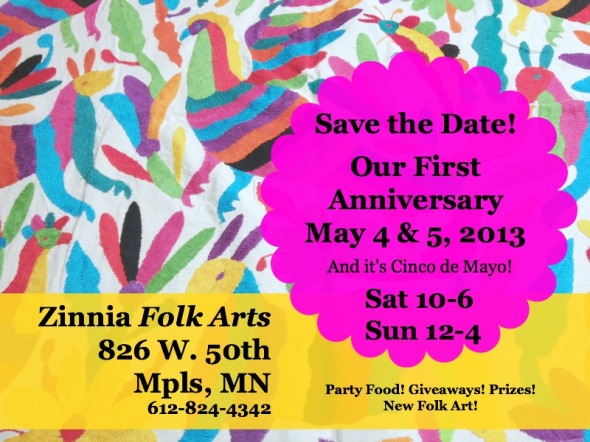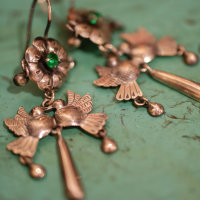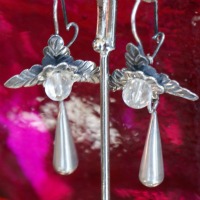Using Vintage Peruvian Textiles for Jewelry
Posted: April 12, 2013 Filed under: Bracelets, Global Style, Peru, Textiles, Zinnia Folk Arts Shop | Tags: Bohemian Style, handmade, Jewelry, Peru, Textiles, Vintage Style 1 CommentI’ve just received some lovely bracelets, handmade in Peru, and they are made from old, faded textiles. They really provide a little spring lift to the winter that will never end–it literally is snowing right now, as I look out my Minneapolis window. Yes, it’s April 12 and there is a home Twins baseball game tonight–expected temp is 34 degrees.
I wouldn’t really call these bracelets folk art, but they are handmade, they do use local materials and they are based on a weaving skill that was handed down from generation to generation. I hope you enjoy them too! Definitely a little color on another snowy day.
Click on the photo or right here to purchase!
Our First Birthday at 50th & Bryant Coming Soon!
Posted: April 4, 2013 Filed under: Mexican Folk Art | Tags: Mexican ceramics, Mexican crafts, Mexican folk art 2 CommentsIf you’re in the Twin Cities, be sure to save the date and join us on May 4 or 5 to celebrate our first birthday AND Cinco de Mayo…fun, food and folk art…Nos vemos!
Mexican Weaving with Natural Palma or Raffia Fibers
Posted: April 1, 2013 Filed under: Mexican Crafts, Mexican Folk Art, Oaxaca, Palma, Weaving | Tags: handmade, Mexican Baskets, Mexican crafts, Mexican folk art, Palma Comments Off on Mexican Weaving with Natural Palma or Raffia Fibers
Silver Mexican Earrings Made by the Mazahua
Posted: March 6, 2013 Filed under: .925 SIlver, Jewelry, Mexican Folk Art, Mexican Jewelry, Mexican silver jewelry, Silver jewelry from Mexico | Tags: Mazahua, Mexican folk art, Mexican jewelry, Mexican silver, mexican style, silver earrings Comments Off on Silver Mexican Earrings Made by the MazahuaThere are some amazing silver artisans in the Mazahua area of Mexico, northwest of Mexico City. They have been making earrings for a very long time. They were deeply influenced by the Spanish conquest of Mexico in the 1500’s. When Spanish women arrived in Mexico they brought many new jewelry styles but in particular a style of earring that was crescent-shaped (arracada) and often wrapped in silver or gold. These styles took root in Mexican silver jewelry making and continue to this day.
One Mazahua silversmith told the author of an article on Mazahua earrings in Artes de Mexico, the meaning of the silver earrings. He said, “The stones symbolize the bright star that comes out at around four or five in the morning. The doves represent the husband going out into the fields to work, and his wife getting up to make atole. The flowers and leaves refer to the countryside, to nature. And the lines are the rays of the Sun.”
When the artisans learn to make these intricate earrings, they practice on less expensive metals such as copper and brass. Once they master the technique, they start using silver wire and silver sheets. To this day the elder artisans teach the younger. Unfortunately, not as many young people are so interested in carrying on the tradition. Like so many types of folk art, the Mazahua earring is at risk of dying out.
All of these earrings are .925 or 92.5% silver. Click on the photograph and you will be taken to the website. If you get a message saying, “This product is no longer available” that means they have been sold. So hurry!
Beaded Huichol Easter Eggs And Bracelets
Posted: March 2, 2013 Filed under: Folk Art, Huichol, Jewelry | Tags: handmade, huichol indians, Mexican crafts, Mexican folk art, Mexican jewelry, mexican style Comments Off on Beaded Huichol Easter Eggs And BraceletsThe Huichol Indians of Nayarit, Mexico are amazingly skilled at beading. Here’s a shot of a few eggs that I have in the shop at the moment. The eggs are carved out of wood, then covered in a thin coat of beeswax, then decorated bead-by-bead. Truly lovely. Not available in the online shop because there are so few but if you’re interested in them, send me a note on the form below. They are $16 for the small and $21 for the large.
And below, is a photo of the amazing beadwork that goes into the bracelets. They move like liquid. Incredibly gorgeous. These are the last two Huichol bracelets I have at the moment and they are available right here.
Brown Mexican Textiles
Posted: February 22, 2013 Filed under: Chiapas, Folk Art, Global Style, Guatemala, Mexican Crafts, Mexican Folk Art, Mexican Style, Mexican Textiles, Textiles | Tags: handmade, Mexican crafts, Mexican folk art, mexican style, Mexican textiles, table runners, Textiles Comments Off on Brown Mexican TextilesWinston Churchill said many things well. And he commented on many things. But who knew he had an opinion about color? The esteemed Mr. Churchill said, “I cannot pretend to feel impartial about colors. I rejoice with the brilliant ones and am genuinely sorry for the poor browns.”
This post is in honor of the poor browns. They tend to take a back seat to their fellow colors, especially in Mexico. These textiles were discovered at the bottom of the pile, underneath the pinks, roses, reds, yellows, bright oranges and greens. They are a quieter bunch. I do think they have a certain beauty. But they don’t always stand out. They are good listeners. They don’t talk unless they have something to say. They shine when they are on their own. They never compete for attention.
Many of these camino de mesas (table runners) or placemats are woven of a natural brown cotton called “coyuche,” a word that comes from the Nahuatl word for coyote. On the other hand, it is possible that it is white thread dyed to look like coyuche, according to research done by an amazing textile archivist by the name of Karen Elwell. Her many photos of Mexican textiles and clothing are always instructional. Her Flickr photostream is right here.
The photos below are the textiles I currently have in the shop. CLICK on the photograph to take you to the shop. Some are in the online store, but if not, just send me an email on the form at the bottom and I’ll let you know if it’s available!
I couldn’t resist with the last photo. Brilliant color with the poor brown.
Frida Kahlo Folk Art
Posted: February 15, 2013 Filed under: Frida Kahlo, Mexican Crafts, Mexican Folk Art | Tags: Frida Kahlo, Mexican crafts, Mexican folk art 4 CommentsProbably the three most recognizable icons of Mexico are the Virgin of Guadalupe, the skeletons of Day of the Dead and the images of the surrealist painter, Frida Kahlo. In every folk art making community in Mexico and created from every type of media, there are pieces of folk art which spring from the omnipresent importance of these ideas.
Frida Kahlo is immediately associated with Mexico and being Mexican and her images, most of them painted by herself, appear in jewelry, nicho boxes, key chains and lots of other objects that attract tourists and native Mexicans alike. She was a beautiful woman! And she has a fascinating story. Those pictures with her monkeys or her parrots make her seem even more exotic. The unibrow defies prescribed beauty notions of the time. The wearing of huipiles from her mother’s Tehuana home in the isthmus south of Oaxaca and the braiding of flowers in her hair were fashion only worn by the indigenous women of Mexico, not those of Frida’s wealth and status. She was unconventional and that’s part of the reason we find her so fascinating. She really did follow her own drummer. A hard thing to do and even harder at a time when women were sidekicks to men…
We have some folk art in the shop right now that focuses on Frida Kahlo…I’ve linked the photos to the online store (click on the photo if you’re interested) and if it’s not linked, you can still purchase it by contacting us through the form at the bottom of the page. Viva la vida!
Going to the Mercado Merced in Mexico City
Posted: February 10, 2013 Filed under: Mexican Crafts, Mexican Folk Art, Mexican Style, Mexico, Virgin of Guadalupe | Tags: Markets of Mexico, mexican style, Virgin of Guadalupe 2 Comments
One of my favorite things to do wherever I am in Mexico is to visit the local market. In Mexico City, there are so many markets to choose from–all of them slightly different and all of them interesting. Yesterday I took the subway to La Merced, one of the largest mercados in the Federal District. It covers an entire block and then spills out into the streets. I took the photo below to show you how empty the subway station was on an early Saturday morning. The Metro is the best thing going in Mexico City. It costs 3 pesos to go anywhere and it’s clean, safe and speedy.

The Metro stops right inside the market so there’s no confusion about where to get off. Just climb up the stairs from the train and boom, you are inside the huge Mercado Merced. I like to wander a bit just looking at the fruits and vegetables, the zapatos, the plastic stuff, but my ultimate destination is always the paper products. There is such a huge variety in so many colors! Valentine’s Day is coming soon, so there’s an abundance of pink and red.

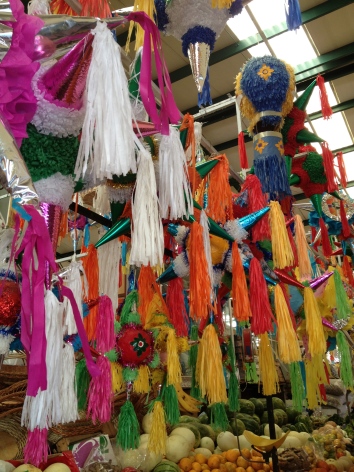
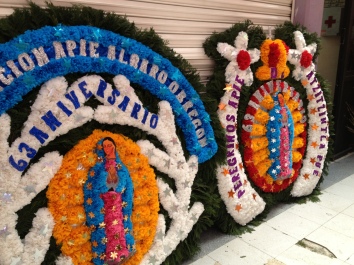
These decorations look like they are decorated with flowers but it’s paper!
Need Some Mexican Folk Art Ideas for Valentine’s Day?
Posted: January 23, 2013 Filed under: .925 SIlver, Global Style, Mexican Earrings, Mexican Folk Art, Mexican Jewelry, Mexican silver jewelry, Silver jewelry from Mexico | Tags: handmade, Mexican crafts, Mexican folk art, Mexican silver, Mexican Silver Jewelry, nickel silver, paper mache Comments Off on Need Some Mexican Folk Art Ideas for Valentine’s Day?Some of these items are on the website–click on the photo and it will take you there. If it’s not on the website and you’re interested in purchasing, let us know through this form!
Zinnia Mexican Folk Arts Shop
Posted: January 11, 2013 Filed under: Folk Art, Mexican Crafts, Mexican Folk Art, Mexican Style, Unique gifts & Jewelry, Zinnia Folk Arts Shop | Tags: Day of the Dead, Folk Art, handmade, Heron Martinez, Mexican ceramics, Mexican crafts, Mexican folk art, mexican style, Textiles Comments Off on Zinnia Mexican Folk Arts ShopI thought you might be interested in the most recent look at how we like to display Mexican folk art at Zinnia Folk Arts shop! We wanted to move the holiday decorations out so I decided to put the vintage (1960’s White Period) Heron Martinez tree of life in the front window and build a colorful support cast of a variety of Mexican crafts. The color is so welcome during these grey days in Minnesota…it’s actually raining today. Enjoy the photos and of course, if you’re in Minneapolis, stop in. We’ll be waiting for you. Saludos!

